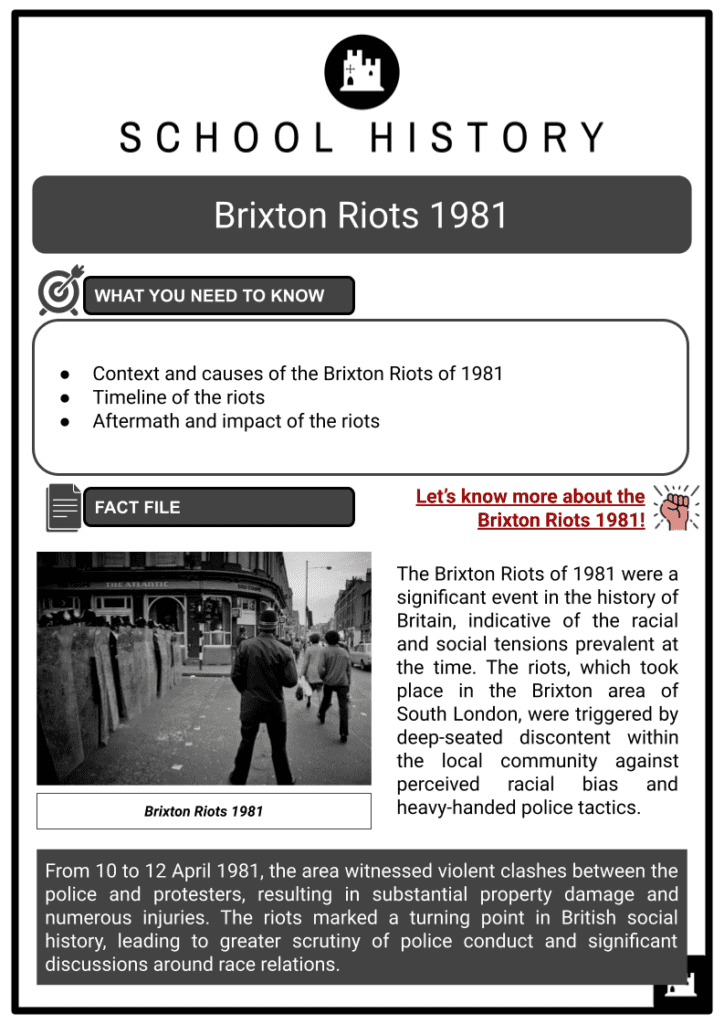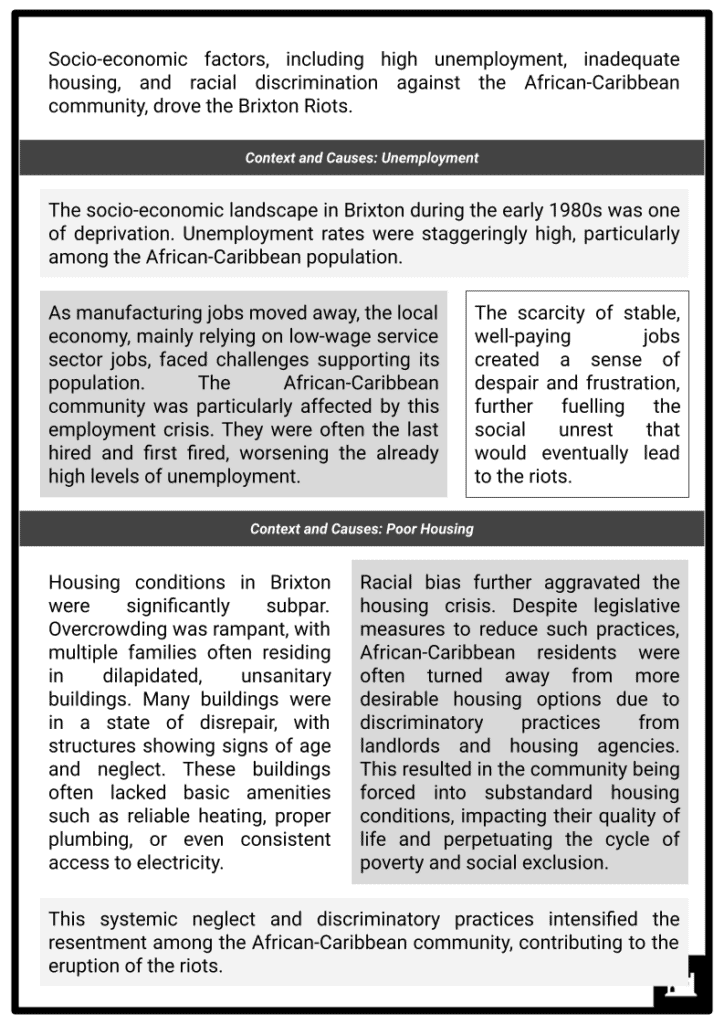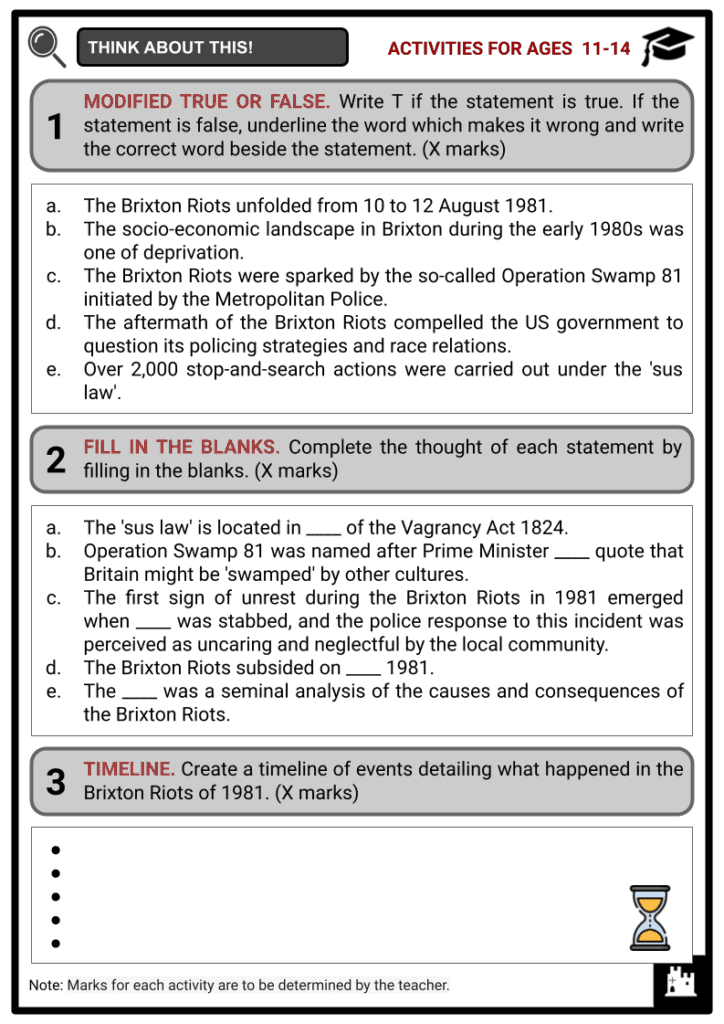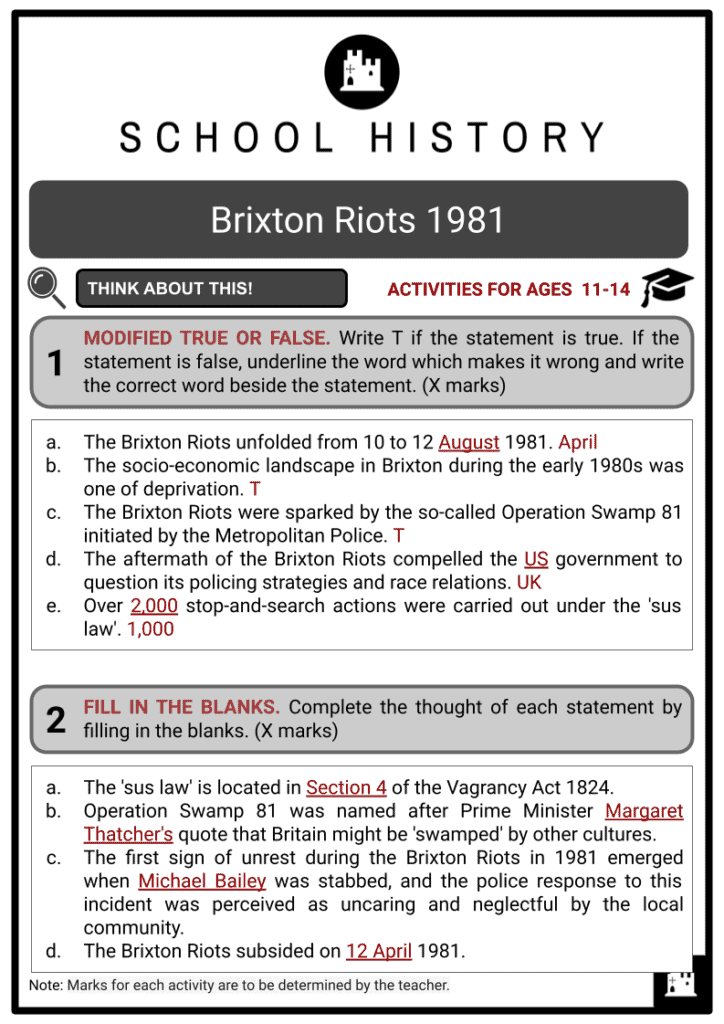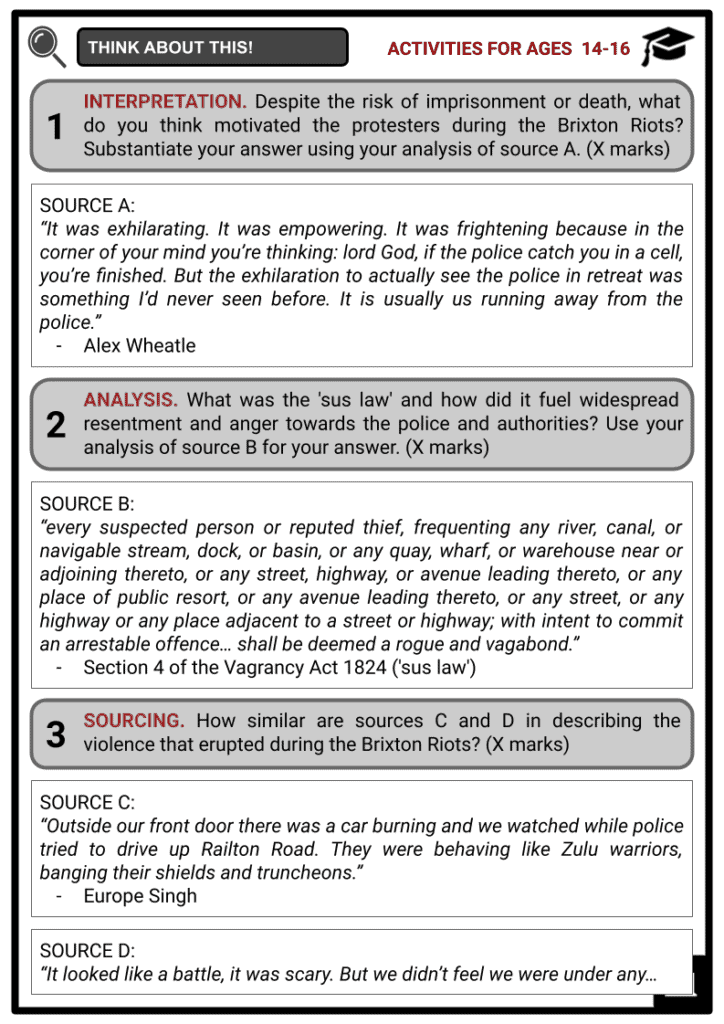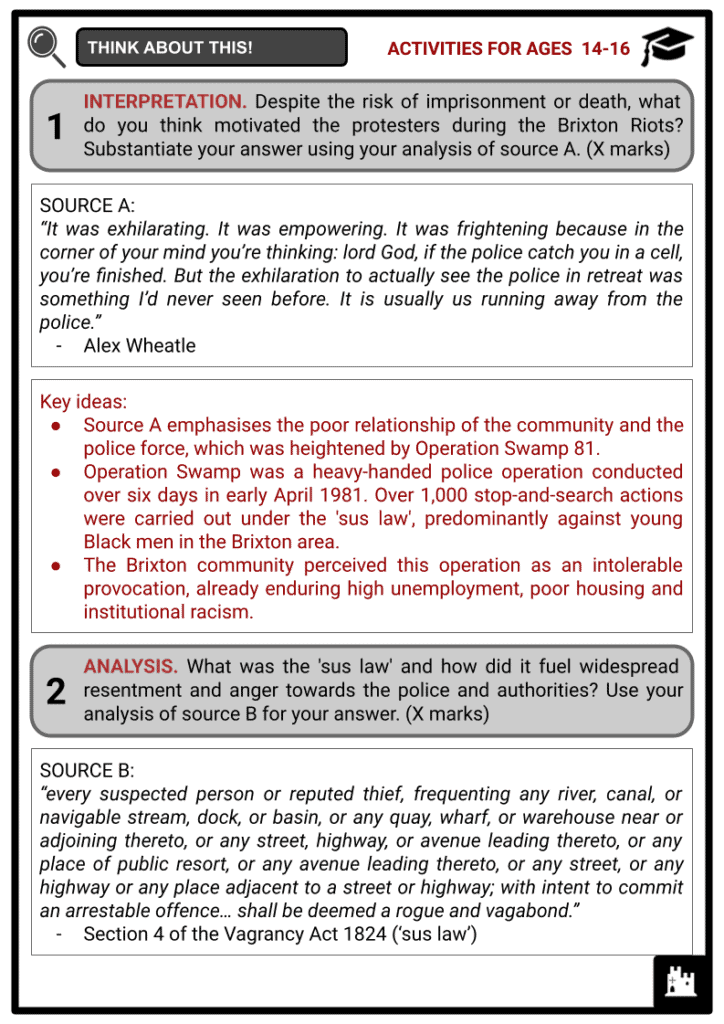Brixton Riots 1981 Worksheets
Do you want to save dozens of hours in time? Get your evenings and weekends back? Be able to teach about the Brixton Riots 1981 to your students?
Our worksheet bundle includes a fact file and printable worksheets and student activities. Perfect for both the classroom and homeschooling!
Summary
- Context and causes of the Brixton Riots of 1981
- Timeline of the riots
- Aftermath and impact of the riots
Key Facts And Information
Let’s know more about the Brixton Riots 1981!
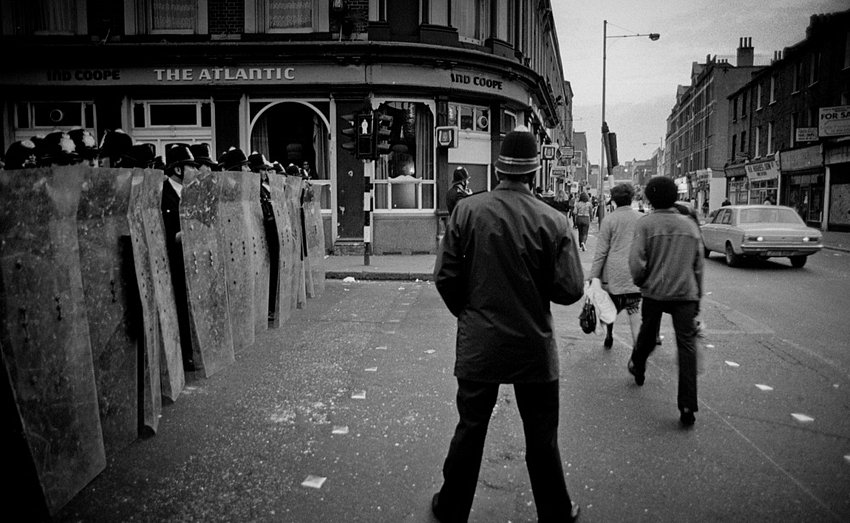
The Brixton Riots of 1981 were a significant event in the history of Britain, indicative of the racial and social tensions prevalent at the time. The riots, which took place in the Brixton area of South London, were triggered by deep-seated discontent within the local community against perceived racial bias and heavy-handed police tactics. From 10 to 12 April 1981, the area witnessed violent clashes between the police and protesters, resulting in substantial property damage and numerous injuries. The riots marked a turning point in British social history, leading to greater scrutiny of police conduct and significant discussions around race relations. Socio-economic factors, including high unemployment, inadequate housing, and racial discrimination against the African-Caribbean community, drove the Brixton Riots.
Context and Causes
Unemployment
- The socio-economic landscape in Brixton during the early 1980s was one of deprivation. Unemployment rates were staggeringly high, particularly among the African-Caribbean population. As manufacturing jobs moved away, the local economy, mainly relying on low-wage service sector jobs, faced challenges supporting its population.
- The African-Caribbean community was particularly affected by this employment crisis. They were often the last hired and first fired, worsening the already high levels of unemployment.
- The scarcity of stable, well-paying jobs created a sense of despair and frustration, further fuelling the social unrest that would eventually lead to the riots.
Poor Housing
- Housing conditions in Brixton were significantly subpar. Overcrowding was rampant, with multiple families often residing in dilapidated, unsanitary buildings. Many buildings were in a state of disrepair, with structures showing signs of age and neglect. These buildings often lacked basic amenities such as reliable heating, proper plumbing, or even consistent access to electricity.
- Racial bias further aggravated the housing crisis. Despite legislative measures to reduce such practices, African-Caribbean residents were often turned away from more desirable housing options due to discriminatory practices from landlords and housing agencies. This resulted in the community being forced into substandard housing conditions, impacting their quality of life and perpetuating the cycle of poverty and social exclusion.
- This systemic neglect and discriminatory practices intensified the resentment among the African-Caribbean community, contributing to the eruption of the riots.
The 'Sus Law'
- The notorious 'sus law' from Section 4 of the Vagrancy Act 1824 fuelled widespread resentment and anger towards the police and authorities. The 'sus law' was a contentious piece of legislation that granted law enforcement officers the authority to stop, search and potentially arrest individuals purely based on suspicion of criminal intent without needing any tangible evidence.
- The practice of arbitrarily detaining people created distrust and dissatisfaction with the police. It particularly affected the African-Caribbean community, worsening prejudices and causing fear. Innocent individuals were often searched or arrested without reason, leading to humiliation.
- The widespread use of this law against the African-Caribbean community not only stoked racial tensions but also contributed to the marginalisation and alienation of the community. The persistent harassment and humiliation endured under the guise of 'sus law' bred an atmosphere of discontent and outrage that eventually led to the riots.
Operation Swamp 81
- The Brixton Riots of 1981 were sparked off by the so-called Operation Swamp 81 initiated by the Metropolitan Police. It was named after Prime Minister Margaret Thatcher's quote that Britain might be 'swamped' by other cultures.
- Operation Swamp was a heavy-handed police operation conducted over six days in early April 1981. Over 1,000 stop-and-search actions were carried out under the 'sus law', predominantly against young Black men in the Brixton area.
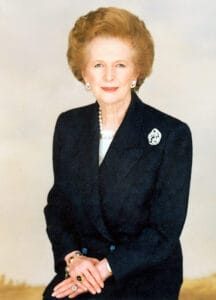
Prime Minister Margaret Thatcher - The Brixton community perceived this operation as an intolerable provocation, already enduring high unemployment, poor housing and institutional racism. The aggressive manner in which the searches were conducted further intensified the sense of injustice and resentment among the locals, especially as many stopped and searched were not involved in criminal activities.
- The police operation did little to arrest actual crime. Instead, it acted as a fuse igniting the area's already volatile social and racial tensions. The distrust and anger towards the police reached a boiling point on 10 April, culminating in the violent outbreak of the Brixton Riots. The unrest directly responded to the deeply seeded issues of racial discrimination, social inequality and police brutality highlighted by Operation Swamp 81.
The Uprising
A Timeline of the Brixton Riots:
- 10 April 1981. Michael Bailey was attacked and stabbed. The perceived neglectful response by the police stirred outrage within the local community.
- 10–11 April 1981. In the days following the stabbing, tension escalated quickly. The streets of Brixton became the stage for violent protest. Looting, arson and skirmishes with the police became commonplace.
- 11 April 1981. The Special Patrol Group (SPG) controlled the situation. However, their presence only exacerbated the violence and destruction.
- 12 April 1981. The riots subsided, leaving Brixton in physical and social ruin. The event is significant in the community's relationship with the Metropolitan Police.
- The first sign of unrest emerged when a young Black man was stabbed, and the police response to this incident was perceived as uncaring and neglectful by the local community.
- The young Black man, Michael Bailey, was returning home when he was unexpectedly attacked and stabbed in the back by an unknown assailant. Bailey was severely injured but went to a nearby bar for assistance. The police were called, but their response was perceived as slow and indifferent by the onlookers, further fuelling the resentment within the community.
- Many witnesses claimed that the police did not immediately provide Bailey with the necessary medical attention, instead prioritising an interrogation. This indifferent handling of Bailey's dire condition was seen as a glaring representation of the police's overall attitude towards the Brixton community, stirring a sense of public outrage.
- In the days that followed, the streets of Brixton transformed into a battlefield, with furious locals clashing with the police. Throughout the riots, there were numerous incidents of looting, arson and violent attacks against the police. The confrontations were fierce and unrelenting – cars were set on fire, barricades were erected, and the air was dense with anger and frustration.
- Numerous victims suffered the brunt of the unrest. The victims were not limited to the physical casualties but extended to those emotionally and psychologically scarred. The riots exacted a heavy toll, with many individuals experiencing direct physical harm, property loss and intense fear.
- Business owners saw their livelihoods destroyed as shops were looted and properties set ablaze. The residents of Brixton, residing in a state of constant dread and insecurity, were arguably the most significant victims. The riots indelibly impacted the community, resulting in deep-seated mistrust, fear and a long-lasting social divide.
- Even with the Special Patrol Group (SPG), a specialist unit of the Metropolitan Police, the disorder persisted. Their presence only made things worse, resulting in more violence and destruction. The riots finally subsided on 12 April, leaving Brixton scarred physically and socially.
Aftermath and Impact
- The aftermath of the Brixton Riots compelled the UK government to question its policing strategies and race relations.
- The Scarman Report, commissioned by the UK government and led by Lord Scarman, was a seminal analysis of the causes and consequences of the Brixton Riots. The report aimed to understand the causes of the violent outbreak and criticised the Metropolitan Police's practices without hesitation.

Lord Scarman - The report highlighted 'policing issues' as the primary catalyst for the riots, particularly the indiscriminate use of 'stop and search' powers (Operation Swamp 81) under the 'sus law'. It further noted the negative impact of growing racial tension and the widespread perception of the police as oppressive and discriminatory.
- The Scarman Report recommended a series of transformations in the approach to policing, particularly in areas with substantial ethnic minority populations. It advocated for better representation of minorities in the police force, more community involvement in policing, and the elimination of the 'sus law'.
- Furthermore, it emphasised the need for better communication between the police and the community and encouraged steps to tackle racial discrimination and social disadvantage. The Scarman Report became a cornerstone for future police reforms and race relations in the UK, although its effectiveness and implementation have remained a topic of debate.
Frequently Asked Questions
- What caused the Brixton riots in 1981?
The riots were fueled by many factors, including high unemployment rates among Black youth, racial discrimination in housing and employment, heavy-handed police tactics (especially stop and search), and frustration with systemic racism and inequality.
- What were the Brixton Riots of 1981?
The Brixton Riots of 1981 were a series of violent clashes between the Metropolitan Police and the predominantly Black residents of Brixton, a neighbourhood in South London, UK. The riots erupted due to long-standing racial tensions, social inequality, and aggressive policing practices.
- When did the Brixton Riots take place?
The riots occurred over the weekend of 10-12 April 1981. The initial spark was the arrest of a young Black man, leading to clashes between the police and the local community.

